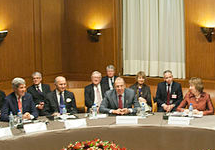Jon B. Wolfsthal
January 17, 2014

Iran Nuclear Negotiations 2013,
WikiMedia Commons
Some initial reactions to the Joint Action Plan Implementation Agreement Summary released by the White House. The agreement addresses all known avenues for Iran’s production of nuclear materials that could be used for weapons.
What the Iran Nuclear Deal Says
Half of all centrifuges installed at Natanz and ¾ of centrifuges installed at Fordow are going off line on January 20th. They will not be permitted under the agreement to enrich uranium, greatly reducing Iran’s ability to produce enriched uranium. All next generation advanced centrifuges are covered under this enrichment freeze.
Iran is not permitted to produce new centrifuges except to replace damaged units – no growth in capacity during interim period. Can use the interim agreement to build a stockpile of units ready to break out.
Half of all of Iran’s near 20% enriched uranium to be diluted with uranium hexafluoride – can remain as UF6. The other ½ stockpile to be converted to uranium oxide – a substance that requires additional process to be re-enriched. This means Iran will stay well below the amount of 20% enriched material needed to make a break for a bomb. Israeli PM had made the amount of 20% a milestone of concern – the interim agreement addresses this effectively.
Progress on Arak reactor all but frozen. No fueling, transfer of equipment, no production of fuel allowed. Also, construction of reprocessing facilities not allowed under interim period. No reprocessing – no access to plutonium. About all Iran can do is produce heavy water, but not in itself a break out issue.
What’s New in the Iran Deal
Iran agrees to daily access of enrichment sites, monthly access to Arak.
Moreover, Iran agrees to provide for the first time:
- Design information on Arak – enables outside work to know what it is, what it is for, what it could do in future if ever completed.
- Managed access to centrifuge production sites and uranium mines and mills.
Parties also establish a Joint Commission – a group of technical experts from each country to monitor compliance and raise issues that might arise to the political directors level.
